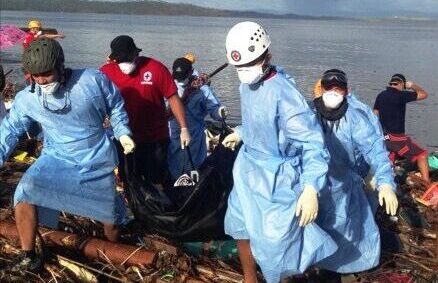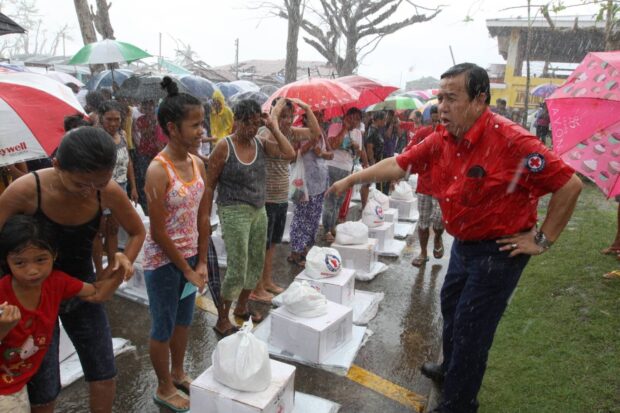Philippine Red Cross and Yolanda: From emergency to recovery

AMONG FIRST ON THE GROUND | More than 8,000 volunteers of the Philippine Red Cross (PRC), including those pictured here were mobilized for the Yolanda response, particularly in Leyte. PRC chair and former Sen. Richard Gordon oversees the aid distribution a few days after the supertyphoon that left more than 6,000 people dead after lashing Eastern Visayas. (Photo from the Philippine Red Cross)
MANILA, Philippines — When Supertyphoon Yolanda (international name: Haiyan) devastated almost the entire Eastern Visayas region a decade ago, Philippine Red Cross (PRC) volunteers were among the first responders on the ground.
Their experience from dealing with the aftermath of the storm that claimed the lives of over 6,000 people led to lessons on disaster response and management: from “taking charge” to continuously improving the deployment of emergency field hospitals and relying on science-based information.
After Yolanda made landfall, PRC chair Richard Gordon recalled, he was in Bohol to coordinate the humanitarian organization’s response after a magnitude 7.2 earthquake struck the island province.
He then received a call from Catherine Gearing, a member of the Australia Red Cross, who found herself trapped in Basey, Samar, in the middle of a project.
“I can still remember her voice: ‘Chairman, you’re the only one who can rescue us. Nothing is moving here, just a lot of looting, some rapes. Please help us’,” Gordon, also a former senator, told the Inquirer in an interview on Monday.
He immediately started the deployment of two “humanitarian caravans” — one from Luzon and the other from Davao — composed of rescue vehicles, ambulances, payloaders, water tankers, and food trucks.
First challenge
The PRC, however, was met with its first challenge: accessibility, both to information and in terms of how to deliver the necessary logistics to the affected provinces of Palawan, Aklan, Antique, Capiz, Cebu, Iloilo, Leyte, and Eastern and Western Samar.
From Metro Manila, the Luzon humanitarian caravan went to the province of Albay and was ferried from the Port of Matnog in Sorsogon to Port Allen in Northern Samar.
“When we got there, there were a lot of body bags …. there were dead bodies everywhere,” Gordon recalled.
On the other hand, the humanitarian caravan from Davao was being blocked by the military and police so he said he had to ask for help from a TV network to persuade authorities to let the rescuers through.
“That’s how it started, there were a lot of problems,” he lamented.

PRC Chairman Richard Gordon, who was also a senator, oversees the aid distribution a few days after the supertyphoon that left more than 6,000 people dead after lashing Eastern Visayas. (Photo from the Philippine Red Cross)
Save own kin first
Before Yolanda’s landfall, however, Gordon said his first order of business was to send a memorandum to all volunteers and staff from different PRC chapters tasking them to prioritize securing their families.
“I want you on your own there. Your families should be out of harm’s way … and you have to be on the ground. It is a heavy job but you have to do it,” he told them.
“I still tear up whenever I see that (memo),” Gordon said.
When the PRC finally reached the typhoon-devastated areas, it established radio communication and blood banks because those set up in hospitals had been destroyed. Volunteers then began distributing relief goods in Samar, Leyte, Southern Leyte, Cebu, Bohol, Negros, Iloilo and then Palawan.
Whistleblower
Gordon said he carried a whistle with him to ensure order in evacuation sites.
One whistle meant the victims must listen to his instructions. Two whistles meant they must gather their families and collect their relief goods, while three whistles were the signal for them to leave the area to make way for another group of victims.
To help survivors reconnect with family members outside typhoon-affected areas, the PRC also provided stations with satellite phones.
Based on the organization’s data, it was able to mobilize more than 8,000 volunteers for Yolanda in addition to coordinating with 300 representatives from 136 international societies that provided support.
To ensure order, Gordon said that he met with the PRC’s international partners and told them to “come in only with [the PRC’s] permission.”
PRC Secretary General Gwendolyn Pang said one of the things she learned from Yolanda was the importance of international coordination and taking charge of the situation.
Gordon, she said, maintained order by instructing their partners to stay in a particular location while the PRC focused on providing the survivors’ most important needs, such as shelter, relief, livelihood, sanitation facilities, hospitals, and schools.
According to Pang, the approach made sure the impact of their response would be more felt.
Science-based
Other lessons from the PRC’s Yolanda experience were giving importance to continuously improving the deployment of the group’s emergency field hospitals and relying on science in risk assessment.
At the group’s Mandaluyong office, there is an operations center where volunteers monitor all situations—fire, earthquake and typhoon—happening nationwide in coordination with government agencies like the Philippine Atmospheric, Geophysical and Astronomical Services Administration.
The PRC also has a map of volunteers with their contact information and location so that during emergencies, there are trained responders to assist them.
During the emergency phase of Yolanda, or from Nov. 8, 2013, to March 30, 2014, the PRC provided food items to around 1.9 million individuals.
In the early recovery phase, it supported 90,779 families with cash assistance and distributed a total of P281.5 million.
Resuming studies
The PRC also helped construct 80,207 shelters and 116 schools with sanitation facilities while 94 health facilities were repaired or rebuilt. Gordon said that priority was given to sending students back to school, which was why by the first week of February 2014, a total of 168 classrooms in Leyte had been built.
The PRC, however, did not leave Yolanda-affected communities immediately after the devastation as they provided training on first aid and rescue for residents in case of flooding. The survivors also received livelihood assistance, cows, goats and other livestock, farming and fishery needs to make sure they would be able to get back on their feet.
Tree planting
In addition, the organization tapped residents for mangrove and tree planting to ensure support for the environment.
Gordon noted that people would always need somebody or an organization like the PRC to support them, especially in times of disaster.
“My frustrations are only subdued by my enthusiasm to continue to work for suffering humanity. If I didn’t do that, I would probably be a broken man,” Gordon said.
“It’s easy to give money but I don’t do that. I want to empower people. I want to enable them,” he added.